Replanting Corn and Yield Loss
When Should Replant Be Considered?
The replant decision is a tough call. Things to consider in this decision include:
- Productive Plant Population: You will need to determine the productive plant population in several areas of the field to help estimate the potential yield of the field if left as is.
- Stand Uniformity: If the productive plant population is not uniformly distributed within the row, additional yield loss will likely occur.
- Original Planting Date: The original planting date plus the remaining productive plant population will be used to estimate the yield potential of the field.
- Likely Replanting Date & Target Plant Population: These will be used to estimate the yield potential of the replanted field.
- Likely Replanting Costs: The cost of replanting a damaged field often makes or breaks a replanting decision. Usual costs include seed, fuel (tillage and planting), additional pesticides, and additional dryer fuel.
- Expected 'Normal' Yields: Estimates of the yield potentials of the damaged field and the replanted field are based on a percentage of 'normal' yield for the field in question. Unless you are excellent at predicting yields for the coming year, consider using a five-year average.
- Expected Market Price for Corn: The dollar gain or loss by replanting obviously depends greatly on what you expect to receive for the grain this fall. The volatility of the grain market this year makes it especially difficult to plug in' a value for determining a replant decision. Use your best guess.
Plant Population
To figure the plant population, use the chart below. Row length equal to1/1000 acre for various row widths.
- Using the chart, find the row width of your planter
- Using the chart, determine how many feet it takes to make 1/1000th of an acre (example: 30” = 17’ 5”)
- At multiple locations throughout the field, count the number of remaining plants in 1/1000th of an acre lengths
- Average your 1/1000th of an acre counts
- Multiply the average of your counts times 1000 for the average population in the field
|
Row width |
Row length equal to 1/1000 acre |
|
20" |
26' 1" |
|
28" |
18' 8" |
|
28" |
17' 5" |
|
36" |
14' 6" |
|
38" |
13' 10" |
|
40" |
13' 1" |
Stand Uniformity
Corn plant skips or gaps in the field cause yield loss. Longer skips usually reduces yield more due to fewer plants, uneven plant placement or possible weed competition. The following chart lists the plant spacing at different row widths and plant populations.
- Corn plant spacing (inches) at four different plant populations and row widths
| Row Width (inches) | 18,000 | 22,000 | 26,000 | 30,000 |
| 30 | 11.6 | 9.5 | 8.0 | 7.0 |
| 36 | 9.7 | 7.9 | 6.7 | 5.8 |
| 38 | 9.2 | 7.5 | 6.3 | 5.5 |
| 40 | 8.7 | 7.1 | 6.0 | 5.2 |
Original Planting Date & Stand Compared To A Later Plant/Replant Date & Stand.
- Corn yield expressed as a percent of the optimum stand and date.
|
Plant Date Established Stand* |
April 20 to May 5 % Yield |
May 20 % Yield |
June 1 % Yield |
June 10 % Yield |
| 26,000 to 30,000 | 100 | 90 | 81 | 67 |
| 22,000 | 96 | 86 | 78 | 64 |
| 18,000 | 91 | 82 | 74 | 61 |
| 14,000 | 80 | 72 | 65 | 54 |
| 10,000 | 65 | 59 | 53 | 44 |
If Corn Plants Are 100% Defoliated At Different Growth Stages, What Is My Potential Yield Loss?

CREDITS:
- Iowa State University
- Purdue University
- University of Wisconsin
Previous
